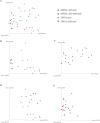Colonic Epithelial Circadian Disruption Worsens Dextran Sulfate Sodium-Induced Colitis
- PMID: 36287037
- PMCID: PMC9977234
- DOI: 10.1093/ibd/izac219
Colonic Epithelial Circadian Disruption Worsens Dextran Sulfate Sodium-Induced Colitis
Abstract
Background: Disruption of central circadian rhythms likely mediated by changes in microbiota and a decrease in gut-derived metabolites like short chain fatty acids (SCFAs) negatively impacts colonic barrier homeostasis. We aimed to explore the effects of isolated peripheral colonic circadian disruption on the colonic barrier in a mouse model of colitis and explore the mechanisms, including intestinal microbiota community structure and function.
Methods: Colon epithelial cell circadian rhythms were conditionally genetically disrupted in mice: TS4Cre-BMAL1lox (cBMAL1KO) with TS4Cre as control animals. Colitis was induced through 5 days of 2% dextran sulfate sodium (DSS). Disease activity index and intestinal barrier were assessed, as were fecal microbiota and metabolites.
Results: Colitis symptoms were worse in mice with peripheral circadian disruption (cBMAL1KO). Specifically, the disease activity index and intestinal permeability were significantly higher in circadian-disrupted mice compared with control animals (TS4Cre) (P < .05). The worsening of colitis appears to be mediated, in part, through JAK (Janus kinase)-mediated STAT3 (signal transducer and activator of transcription 3), which was significantly elevated in circadian-disrupted (cBMAL1KO) mice treated with DSS (P < .05). Circadian-disrupted (cBMAL1KO) mice also had decreased SCFA metabolite concentrations and decreased relative abundances of SCFA-producing bacteria in their stool when compared with control animals (TS4Cre).
Conclusions: Disruption of intestinal circadian rhythms in colonic epithelial cells promoted more severe colitis, increased inflammatory mediators (STAT3 [signal transducer and activator of transcription 3]), and decreased gut microbiota-derived SCFAs compared with DSS alone. Further investigation elucidating the molecular mechanisms behind these findings could provide novel circadian directed targets and strategies in the treatment of inflammatory bowel disease.
Keywords: circadian disruption; metabolomics; microbiota; peripheral circadian disruption; ulcerative colitis.
Plain language summary
Disruption of peripheral circadian rhythms of the colon epithelium results in worse colitis and increased intestinal permeability in mice when given dextran sulfate sodium. This may be mediated through alterations in microbiota, butyrate levels, and STAT3.
© 2022 Crohn’s & Colitis Foundation. Published by Oxford University Press on behalf of Crohn’s & Colitis Foundation.
Figures





References
Publication types
MeSH terms
Substances
Grants and funding
LinkOut - more resources
Full Text Sources
Miscellaneous

